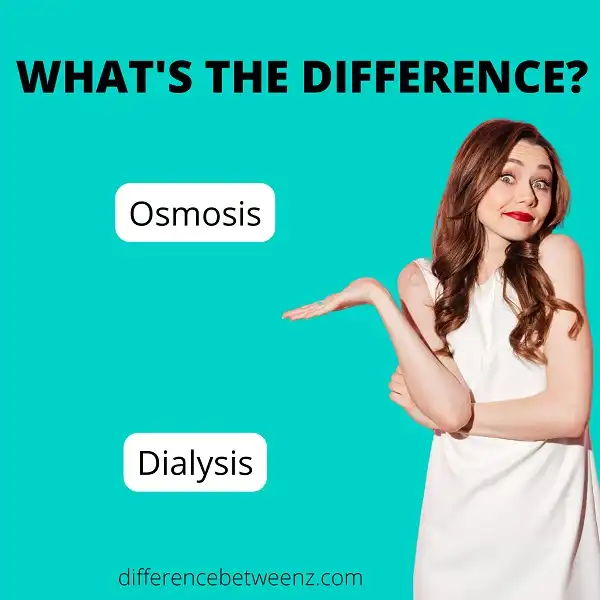Osmosis vs Dialysis
Difference between osmosis and dialysis: – There are certain processes that occur within the human body and are necessary for the survival of each one of us. Osmosis, diffusion, respiration … are some of these. Osmosis occurs inside cells, which absorb and diffuse the nutrients by passing them through a semi permeable membrane. The kidney is the organ that performs the important task of maintaining balance in the body by filtering the blood, the liquid in the body and separating excess water and waste from it. It also functions as part of the endocrine system. Dialysis instead, is a medical procedure that is required when the kidneys are no longer able to function properly. Read on for further reading. Below you will learn the difference between osmosis and dialysis.
Difference between osmosis and dialysis
Osmosis
Osmosis is a type of diffusion, where molecules move through a semi permeable membrane and become a more concentrated solution of a more diluted solution.
A semi permeable membrane is a barrier that only allows passing to certain substances and blocks the passage to all the others. A cell wall is a semi permeable membrane, as it allows water and certain substances diluted in it to pass. The or osmosis water requires that the substances can pass through the membrane. By means of the transport of substances the concentration of these on the two sides of the membrane is equalized.
It is divided into three stages: hypotonic, isotonic and hypertonic. When it is hypotonic, the external solution is less concentrated than the inner solution, whereas in hypertonic solutions, the external solution is more concentrated than the inner solution. Instead it is isotonic when the equilibrium between the two solutions is reached and they have the same concentration.
Osmosis is used by various cells and organisms in order to achieve balance. Cells also use it to acquire nutrients and energy. Cell membranes act as semi permeable passages, allowing large and polar molecules such as ions, proteins and polysaccharides to pass; while blocking non-polar or hydrophobic molecules such as lipids, oxygen, carbon dioxide, nitrogen, nitric oxide…
Osmosis is also the main way in which plants acquire water and nutrients needed from the ground for their survival. The process of soil water absorption is osmosis.
Dialysis
Dialysis is a medical process that helps to perform the functions of the kidneys when they are no longer able to work. The term derives from the Greek word ‘dialysis’ which means ‘dissolution’. It is an artificial replacement that can be gradual or instantaneous.
It helps to separate waste and excess water from the blood. It can also be partially used to treat people who are applicable for a kidney transplant. In addition, it is used when a person loses between 85-90% of kidney function.
The purpose of dialysis is to maintain balance in the body when the kidneys cannot. It does this by removing waste, salt and excess water thus preventing it from accumulating in the body. It regulates the level of chemicals and nutrients (potassium, sodium, chloride, calcium, phosphorus, magnesium and sulfate) in the body and also helps to control blood pressure. The kidneys are part of the endocrine system and produce erythropoietin and calcitriol, which aid in the production of red blood cells.
The first dialysis machine was developed in 1943 by the Dutch physician Willem Kolff; however, the first success story occurred in 1945. The machine was made using casings, beverage cans, a washing machine and other objects that were available at that time.
This process uses principles such as diffusion and ultra filtration of liquid through a semi permeable membrane. L blood flows on one side of the semi permeable membrane and the dialyzed flow on the opposite side. The semi permeable membrane has small holes that allow blood substances to pass through it. Once the blood is cleansed, it is reinserted in the body.
There are five types of dialysis, of which three are primary and two are secondary. The primary ones are hemodialysis, peritoneal dialysis and hemofiltration, while secondary ones are hemodiafiltration and intestinal dialysis.
In the case of hemodialysis, the patient’s blood is pumped through the compartment of a dialyzer, while in the other compartment of the apparatus the dialyzed substances remain. The clean blood is then returned to the body. This is a process that usually lasts 3-5 hours and must be done three times a week.
In peritoneal dialysis, blood is cleansed within the body itself through a tube that is placed inside the peritoneal cavity in the abdomen. The cavity is filled with the dialyzed substances thanks to a surgically placed catheter, this keeps the arteries and veins clean. The fluid containing the waste is removed through the same catheter.
Each exchange takes about an hour or an hour and a half and the dialyzer catheter should be changed four or five times a day. The e-filtration is a process similar to hemodialysis, but unlike it is done by the use of pressure.


